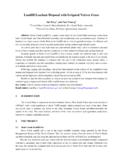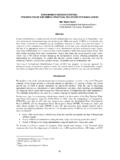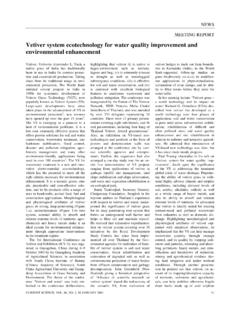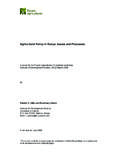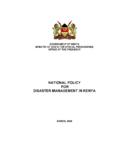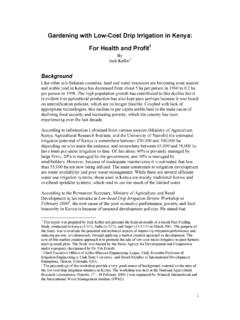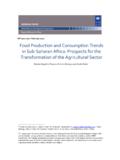Transcription of Lake Naivasha - VETIVER
1 lake Naivasha A lake in TroubleA Possible Solution?THE PROBLEMS ignificant and dangerous reduction in the sizeof the lake Naivasha water body and seriousdegradation of water quality caused quantities of sediment inflow from Malewa and water inflows in low rainfall inflows from Naivasha town and intensive flowerenterprises adjacent to lake . These pollutants include highlevels of phosphates, nitrates, and pesticide residues, and water extraction through uncontrolled presentation focuses on items 1, 2 and 3 Northern shore of lake Naivasha . From Left to right: VETIVER hedgerows on Loldiafarm, Gilgil river flood plain, Malewa Flood plain and delta. Serious sediment inflowsto lake Naivasha derive from catchments of the Malewa and Gilgil RiversMalewa riverMalewa Flood Plain and DeltaGilgil Flood PlainVetiver HedgerowsApproximate farmed catchment area of Malewa (160,000 ha) and Gilgil (60,000ha) rivers that drain the western Aberdare mountains.
2 The upper catchmentscomprise some of the most intensive and high density small farms in west lake Naivasha - intensive flower industry. These businessesdischarge agrochemical effluent into the lake either through drainagewater or through storm water IndustryEast end of lake Naivasha near Crescent Island showing eutrophic bloom and silt effecton lake water. Crescent Island lake is clean. On-land effluent discharge to lake isfrom intensive high input farms and nearby lake Naivasha and eutrophic bloomIntensive high input agricultureTHE VETIVER SYSTEM COULD BE AN IMPORTANTCOMPONENT OF THE TECHNICAL VETIVER System (VS) flooding by slowing down rainfall runoff in Malewaand Gilgil river catchment erosion in the catchment sediment on lakeshore chemical pollutant inflow from flower industry, highinput agriculture, and Naivasha groundwater and related ground water inflows torivers and streamsWHAT IS THE VETIVER SYSTEM?
3 The VETIVER grass (Chrysopogon zizanioides), planted as a denselong-living hedgerow across the land grass has deep (4m) roots that have a tensile strength ofmild steel (75 MPa). hedge row will trap as much as 90% of the silt in rainfallrunoff and will reduce run off by as much as 70%. of its deep and penetrating roots this saved runoffrecharges groundwater. The latter will be released to improvethe flow of streams and rivers throughout the grass is drought proof and is NON plant will remain in place for plant is already growing in the Naivasha area and hasbeen in Kenya for at least 80 years. Some growers aremultiplying it in nurseries. Multiplication is quick and : 6 year old VETIVER grass onLoldia farm, north shore, LakeNaivasha.
4 This VETIVER was notplanted correctly (too far apart) - nohedge formation and on existingcontour bunds, and is consequentlyfar less effective, as it does notcreate a filtration barrierLeft: VETIVER grass in Ethiopia -same genotype as Kenya VETIVER -grown at 1700m aslSILT INFLOW REDUCTION TO LAKER iver catchment areasVS would be used to systematically:Stabilize upstream eroding catchment areas of Malewaand Gilgil rivers (applied to farm land and to pointsource high sediment producing areas such as riverbanks, gullies, and road sides).Note: VETIVER hedgerows are a total substitute for farmcontour bunds (fanya-ju). In Ethiopia farmers using VShave increased crop yields by 30-50%.
5 Initially Vetiverwas used to stabilize existing terraces. However thepreferred and most method is to create hedgerowsdirectly on farm land without initial terracing. Saveslabor, reduces rat problems and is much more to 6 year old VETIVER hedgerows inEthiopia. Some were planted on oldterraces; the cut hedge on the left wasplanted on unterraced land and over theperiod has created, through trappingerosion sediment, a natural terrace that is30 cm high (James Owino from Edgertonbottom left). The leaf of the grass is cut forforage, thatch, mulch, fuel, and forhandicraft material. VETIVER reduces stemborer in maize. In Mettu district (westernEthiopia, 1700 m asl) more than 20,000farmers are using the catchment on farm erosion controlThis 30 year old VETIVER hedgerow in Fiji has trapped enough sediment tocreate a natural terrace riser that is 2 meter high.
6 The balance of the rainwaterrunoff that passed through the hedgerow was sediment hedgerows from space - western Ethiopia - 8 'N 35 'E. Altitude 1,700 m asl. Some of these have been inplace for more than 20 hedgerowsVetiver hedgerows protecting farm land in western Ethiopia. Thedissemination of the technology started with an NGO, and then driven byfarmer to farmer advice and plant material supply. Note: very little evidenceof 8 'N 35 'EVetiver grass hedgerowsCatchment flood and gully controlIntensive rainfall runoff can resultin serious erosion and images to the left show howVetiver will prevent erosion inupper catchments in Australia,and can repair gullies (above) inFiji (dark green grass + point source erosioncontrolRiver bank stabilization using Vetivergrass at highly erodible locations - left:Zimbabwe; center: Australia.)
7 Road cutand fill are major sources of erosion; righttop: VETIVER stabilizing a road cut atJimma, Ethiopia; right bottom stabilizingfill in erosion control In the wet season water from the Malewa and Gilgil rivers floodthe delta area in the north eastern part lake Naivasha . This isflat land. The Malewa has a defined river course, but the Gilgilis less well defined. One solution would be to establish VETIVER hedgerows acrossthe delta area at about 100 m intervals. If the the hedgerowlines were first established with a bulldozer to flatten the line andthen planted (possible by machine) with VETIVER , very effectivebarriers could be established. Wildlife could move through thehedge rows but would not destroy them.
8 Considerable siltdeposits could be expected behind the hedgerows. This is demonstrated through the following slides of Vetiverhedges on the black soils of the Queensland s Darling Downsthat can be subjected to major floodingVS for Flood PlainsLeft: Gilgil River Flood plain adjoining Loldia Farm . Right: a part ofthe Darling Downs laid out with VETIVER hedgerowsTop left: VETIVER Hedgerow on blackcracking soils of the Darling left: 50 cm water floodedthis area, depositing large amountsof sediment behind VETIVER did not collapse fromthe pressure of water, and willcontinue to grow under floodedconditions. Top right: plantingVetiver with vegetable planter. Italso recovers very quickly after Catchment Ground WaterRechargeIn Ethiopia it has been well demonstrated that Vetiverhedgerows will increase the recharge of ground waterand will provide the means for the restoration ofwetlands.
9 Restored wetlands act as a sponge for theslow release of water downstream thus improvingstream water recharge 1. Improved Spring FlowThis 500 ha farm in Ethiopiawas fully protected with Vetiverhedgerows (left), resulting inmuch higher crop yields and(above right) an annualpermanent flow of potablespring water where there wasnone before the VetiverapplicationGround water recharge 2. Wetland RestorationIn Ethiopia, under a similar climate as the Mau forest area, extensive areas of farm landhave been protected with VETIVER hedgerows (top left). These hedgerows, in some caseshalted erosion and runoff entirely, resulting in substantial crop yields due to improved soilmoisture, better soil fertility (the latter - reduced loss of fertilizer, and improved soil structure,organic matter, and nutrients though mulching with VETIVER .)
10 An unintended benefit was therestoration of adjacent wetlands (top right). Before VS was used this area was dry and usedfor football games. Now it has been restored by groundwater. You can see bodies of life (migrating birds) have returned, and substantial forage sources are now the Ethiopian Wetland Society is a major promoter of the VETIVER SystemPollution ControlResearch and full scale applications ofVS for pollution control has beendemonstrated in Australia, China, andThailand. When correctly designed andapplied VS can be used to stabilize andprevent pollutant flows from landfills,sewage works, and from industrial andagricultural effluent dischargePollution ControlVetiver hedgerows if planted as constructed wetlands phosphate and nitrates in effluent by over 90%meeting environmental code and most agrichemicals such as herbicides high levels of heavy metals such as lead, arsenic,copper etc, and will hold the metal in its root system (exceptfor lead that is translocated to the ControlIn the lake Naivasha area VS could be used and prevent seepage from Naivasha town nitrates.)
